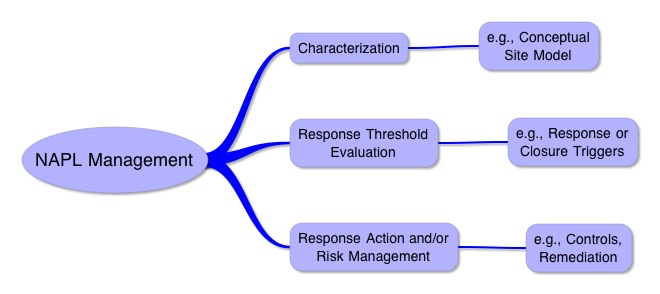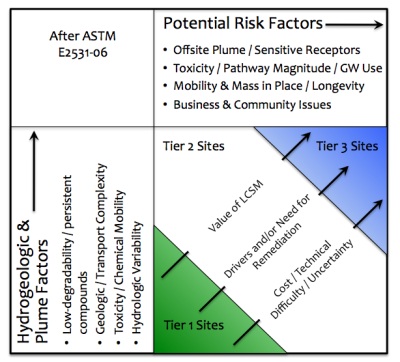Applied NAPL Science Review
Demystifying Science for the NAPL Site Manager
ANSR Scientific Review Board
J. Michael Hawthorne, PG, Board of Chairman, GEI Consultants Inc.
Mark Adamski, PG, BP Americas
Dr. Randall Charbeneau, University of Texas
Dr. Sanjay Garg, Shell Global Solutions (US) Inc.
Dr. Terrence Johnson, USEPA
Andrew J. Kirkman, PE, AECOM
Mark W. Malander, ExxonMobil Environmental Services
Applied NAPL Science Review is a scientific ejournal that provides insight into the science behind the characterization and remediation of Non-Aqueous Phase Liquids (NAPLs) using plain English. We welcome feedback, suggestions for future topics, questions, and recommended links to NAPL resources. All submittals should be sent to the editor.
Building the NAPL Conceptual Site Model: A Tiered Approach to Measured versus Modeled Data
Andrew Kirkman, PE – AECOM
Background: To date ANSR has discussed specific tools and concepts applicable to developing conceptual site models for NAPL-impacted sites. With this issue, we “zoom out” to provide a broad framework for NAPL site characterization and the overall site management process. This issue lays out in detailed form a tiered approach to development of measured versus modeled site characterization data to develop a sound NAPL conceptual site model (a subset of a comprehensive multiphase conceptual site model).
Discussion: In general three broad categories of tasks are required to manage NAPL sites: 1) characterization, 2) response threshold evaluation, and 3) response action and/or risk management (e.g., remediation, controls). The characterization task is intended to culminate in development of a NAPL conceptual site model sufficient to guide management of potential NAPL issues at a site.

The importance of a sound NAPL conceptual site model cannot be overstated whether evaluating a site against threshold decision metrics or designing a NAPL remediation system. The soundness of a conceptual site model should be evaluated based on the type of information required as well as the scale of investigation appropriate to correctly understand the nature and distribution of NAPL, to accurately evaluate the potential regulatory or risk issues NAPL poses at a site, and to design and implement an efficient system of control(s) and/or remediation.
In this article, we provide a practical guide to key elements of a NAPL conceptual site model in terms of measured versus modeled parameters by each of three successively complex tiers (Tier 1 is simplest, 3 is most complex). Tiers for conceptual site model development may be defined in multiple ways, including but not limited to:
- by site subsurface complexity,
- by NAPL release or plume size,
- by increasingly complex tiered lists of characterization tasks,
- by potential exposure pathway,
- by sensitivity of potential receptors,
- by density of investigation sampling.
In practice it is not uncommon for many of these to come into play for a given site.

As an example: A site with multiple NAPL-bearing lithologic layers across a large areal extent may warrant Tier 3 conceptual site model development based on site complexity and size, with a comprehensive set of Tier 3 investigative tasks completed. However, those Tier 3 tasks might only be implemented along the potentially complete vapor intrusion pathway if no other pathway is complete, and the sampling density (e.g., soil and vapor samples) may be substantially higher along the vapor intrusion pathway. Incomplete pathways (e.g., groundwater migration/ingestion) at such a site may only require a Tier 1 or 2 conceptual site model to guide NAPL management activities to protect human health and the environment.
Table 1 provides a breakout listing by task and tier of information and analyses that will often be appropriate to develop a sound NAPL conceptual site model. The table does not include all possible information that could be developed, but rather a practical “starting point” of elements for each tier. Precise boundaries between each tier are not provided, and for any given site the table may require modification to satisfy site-specific complexities or regulatory requirements. Where multiple tiers are identified for a given task, the difference in tier designation will typically depend upon site subsurface complexity and/or density of sampling for the given task.
Several ANSR Review Board members are currently participating on an ASTM International® (ASTM) team that is reviewing ASTM E-2531 LNAPL Conceptual Site Model guidance for potential updates and reauthorization by ASTM. We welcome input from the ANSR community of readers with comments on the NAPL conceptual site model approach suggested herein and reader suggestions for implementation in the ASTM guide. Comments should be directed to ANSR.
Real World Limitations: A word of caution – The world is composed of shades of grey, and specific demarcations are always subject to interpretation and variance in the real world. The conceptual site model approach discussed is a practical approach that includes a reasonable content sufficient to characterize a sound NAPL conceptual site model at most sites. But it should not be applied as a “black box” without oversight and management from qualified geological, hydrogeological and other relevant experts.
